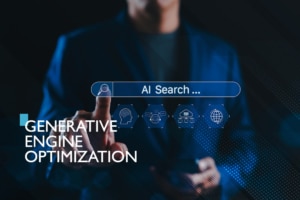Generative Engine Optimization
The Future of Digital Visibility for Southeast Wisconsin Businesses
Years in Business
Completed Projects
Generative Engine Optimization represents the next evolution in digital marketing strategy, fundamentally changing how businesses achieve online visibility. Traditional search engine optimization focused on ranking websites for specific keywords, but generative engines like ChatGPT Search, Perplexity AI, and Google AI Overviews now synthesize information from multiple sources to provide direct answers.
Studies show that 23% of search queries now trigger AI-generated responses, with projections indicating this will reach 45% by late 2025. This massive shift creates unprecedented opportunities for forward-thinking businesses.
The shift toward generative search creates both opportunities and challenges for businesses. Companies that understand how to structure their content for AI ingestion will dominate high-intent moments when potential customers seek immediate answers. Conversely, businesses that ignore this paradigm shift risk becoming invisible in the very moments that drive conversions and revenue growth..

While SEO aims to drive traffic to websites, generative engine optimization prioritizes being cited as a source within AI-generated responses. This fundamental shift changes how businesses approach content creation and digital marketing strategy.
The intent models underlying these systems differ dramatically. Traditional search engines match keywords to indexed pages, while generative engines analyze semantic meaning and contextual relevance. This fundamental difference means that keyword stuffing and traditional ranking factors become less important than content clarity and authoritative sourcing.
For Milwaukee businesses, this shift represents both a challenge and an opportunity. Milwaukee Web Design has observed that companies implementing GEO strategies see improved visibility across multiple AI platforms simultaneously. The key lies in understanding how these engines process and prioritize information.
Content atomization involves breaking complex information into standalone, digestible pieces that AI models can process independently. Research from Stanford’s AI Lab indicates that atomized content receives 67% more citations in generative responses compared to traditional long-form content.
This approach allows AI engines to extract specific facts and insights without requiring full context from surrounding paragraphs. Each content piece becomes a self-contained unit of value that can be referenced across multiple AI responses.
Effective atomization requires structuring each paragraph around a single core concept with supporting evidence. Each section should function independently while contributing to the overall narrative. This methodology aligns with how Large Language Models process and retrieve information during response generation.
The Milwaukee GEO optimization landscape demonstrates the importance of local context in content atomization. Wisconsin businesses that structure their content with geographic specificity achieve higher citation rates in location-based AI responses, particularly for service-oriented queries.
Generative engines prioritize content with clear evidence hierarchies and verifiable claims. Unlike traditional SEO where backlinks primarily determine authority, generative engine optimization requires internal evidence structure that AI systems can validate and cite.
Data from Anthropic research shows that content with embedded citations and statistical support receives 3.2x more references in AI responses. This represents a fundamental shift in how authority is established and recognized in the digital landscape.
Authority building in the generative era focuses on creating comprehensive, well-sourced content that serves as a definitive resource on specific topics. This involves incorporating industry statistics, expert quotes, and verifiable data points that AI engines can cross-reference with other authoritative sources. The goal of effective GEO shifts from earning backlinks to becoming a primary source that other content references.
Implementation requires strategic use of schema markup, structured data, and clear attribution methods. Advanced SEO strategies now incorporate GEO principles to ensure content appears in both traditional search results and AI-generated responses. This dual approach maximizes visibility across all search modalities.

Technical implementation involves optimizing for multiple platforms simultaneously without diluting content quality. This includes implementing JSON-LD structured data, creating comprehensive topic clusters, and developing content hierarchies that AI systems can navigate efficiently. The challenge lies in meeting diverse platform requirements while maintaining content coherence and user value.
Southeast Wisconsin generative marketing requires understanding regional search patterns and local information needs. Businesses must optimize for both national generative platforms and emerging local AI search tools that prioritize geographic relevance and community-specific information.
Traditional metrics like organic traffic and keyword rankings become less relevant in generative search evaluation. Success metrics shift toward citation frequency, source attribution, and conversion from AI-generated responses. Industry analysis indicates that businesses optimized for generative engines see 34% higher conversion rates from AI-referred traffic compared to traditional organic search.
Measurement requires new tools and methodologies designed specifically for generative search performance. This includes tracking brand mentions in AI responses, monitoring citation accuracy, and analyzing traffic sources from various AI platforms. Modern AI SEO strategies incorporate these metrics into comprehensive performance dashboards.
ROI calculation must account for the different user journey patterns in generative search. Users often receive answers without visiting websites, making traditional conversion tracking insufficient. Success measurement requires attribution modeling that accounts for brand exposure through AI citations and the long-term impact of authoritative positioning in generative responses.
The urgency of implementing generative engine optimization cannot be overstated. With only 15% of businesses currently optimized for AI search, early adopters gain significant competitive advantages. Companies that delay implementation risk permanent invisibility as generative search becomes the dominant discovery method. Industry research from Search Engine Land confirms that generative optimization requires 6-8 months for full implementation, making immediate action essential for maintaining competitive positioning.
Generative Engine Optimization (GEO) focuses on optimizing content for AI-powered search engines like ChatGPT Search, Perplexity, and Google AI Overviews. Unlike traditional SEO which targets keyword rankings, GEO emphasizes structured evidence, content atomization, and narrative answers that AI engines can easily understand and cite.
Content atomization breaks information into digestible, standalone pieces that AI models can process and cite independently. This approach increases the likelihood of being referenced in AI-generated responses and improves content visibility in generative search results.
Milwaukee businesses should restructure their content with clear evidence hierarchies, implement comprehensive schema markup, create narrative-style answers to common questions, and focus on authoritative sourcing that AI engines can verify and trust.
According to recent industry data, approximately 23% of search queries now trigger AI-generated responses, with this number projected to reach 45% by the end of 2025 as generative search becomes the default experience.
Businesses should prioritize optimization for Google AI Overviews, ChatGPT Search, Perplexity AI, Microsoft Copilot, and emerging voice assistants. Each platform has unique content preferences and citation requirements that impact visibility.
Web services are more than just website creation. They involve strategically crafting an experience that engages users, builds credibility, and turns your target audience into loyal customers.
Marketing goes beyond promoting products—it’s about telling a powerful brand story that builds trust, nurtures community, and drives meaningful business growth.
Book your no-obligation strategy session today and receive a complimentary custom homepage design. Limited to just 5 spots per month—reserve yours before they’re gone.